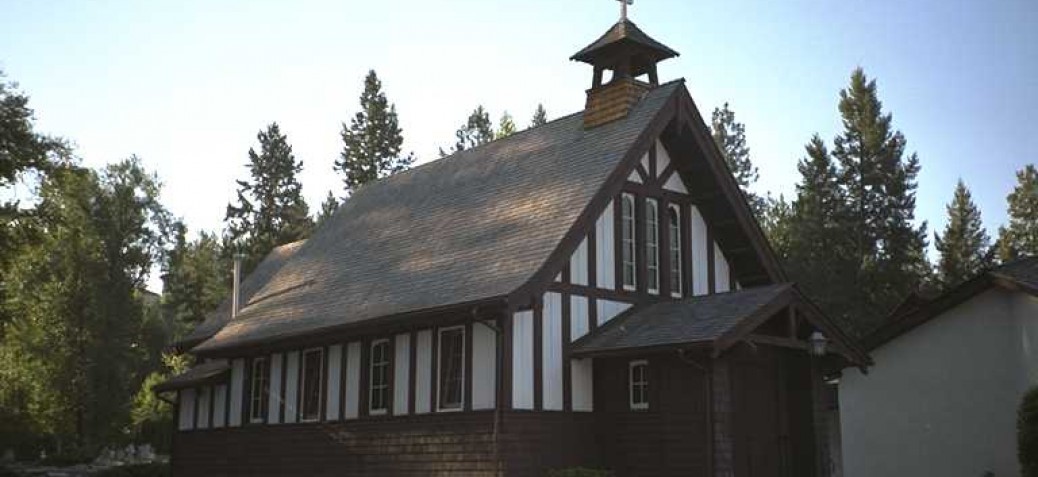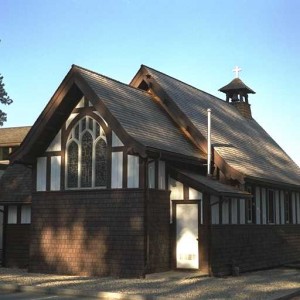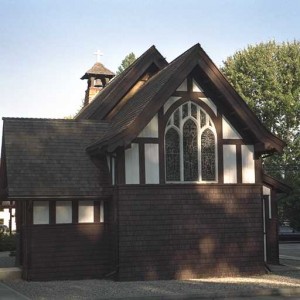St. Andrew's Church
Place Description
The historic place is the half-timbered wood-and-stucco St. Andrew's Anglican Church, built in 1910-11 in the Tudor Revival style, and located at 4619 Lakeshore Road in Kelowna's Mission Sector.
Heritage Value
The building has value as the oldest surviving Anglican Church in Kelowna, for reflecting the early settlement of the Mission district, as a very good example of a Tudor Revival parish church, and for having an adjacent churchyard cemetery.
Okanagan Mission, as the neighbourhood is now known (the area south of Mission Creek), developed somewhat later than the main Kelowna settlement. Not until around 1900 were there many settlers. Those who came at that time were predominantly from England, including a fair share of 'remittance men'. Their origin is reflected in the fact that an Anglican church that is very English in character was the first built in the area, and for a long time remained the only house of worship.
The Anglican minister from Kelowna, the Reverend Thomas ('Daddy') Greene, held occasional services at Okanagan Mission from before 1900, traveling down by horse and buggy along Swamp Road. Within the decade there were enough Anglicans to consider building a church. J.H. Baillie donated a half-acre of land, and money collection began. Plans for a church in the Tudor Revival style were drawn up in 1910 by Wesley A. Peters, one of the few architects practising in Kelowna at the time, and the designer also of the city's First United Church and St. Michael's and All Angels Anglican Church. St. Andrew's was built by W. Shand, who lost an arm during construction when a cedar splinter caused an infection, and the building was completed by his son.
The first service in the Church was held by the Reverend T. Greene in February 1911, and it was consecrated in April 1911 by Dr. DePencier, the Bishop of Westminster and Kootenay. The offertory of that day was sent as a contribution to the Building Fund for the new St. Michael and All Angels' Church in Kelowna, then just getting under way to designs by the same architect.
The Tudor Revival style, characterized by its simulated half-timber construction, was popular at the time in Kelowna and throughout British Columbia for buildings that were intended to be associated with English tradition. Here the Tudor Revival is combined with features of the Gothic Revival style, specifically the parish church revival of the Victorian era, which in turn was associated with Anglicanism.
An additional quarter acre of land was purchased in 1917 to extend the cemetery behind the church, which was consecrated in 1922 but in use earlier. Churchyard cemeteries are very common in rural churches in England, but rare in this part of the world.
St. Andrew's looked likely to soon become a separate parish from Kelowna, but the First World War took many of the parishioners away and the impulse faded. The War Memorial Tablet, dedicated in 1921, recalls sixteen local men who died in service in the Great War; the Lychgate, erected in 1947, remembers seven who died in the Second World War. It was not until 1947 that the separate Missionary Parish of Okanagan Mission came into being, achieving full self-supporting status in 1957.
The suburban growth of Okanagan Mission after the Second World War greatly increased the size of the congregation, and as early as 1961 the capacity of the church was being strained. Eventually it could no longer serve the expanded congregation. First a new church hall and then a new much larger St. Andrew's Church, with a capacity of 300, were built in 1985-87 beside, and rather overshadowing and dwarfing, the old St. Andrew's Church, which is now used only for small services, weddings, and funerals.
Character Defining Elements
- Tudor Revival features, particularly the simulated ('false') half-timber framing (dark-stained wood members with light stucco infill)
- Gothic Revival features, including the pointed-arched stained-glass windows, the steep gabled roof
- Bellcast eaves
- Character of an English Anglican parish church, seen in the small scale, simple massing, expressed chancel, and transept
- Projecting entrance porch
- Small belfry topped by a cross
- Arts and Crafts details, seen in features such as the expressed rafters and fascia boards
- Board-and-batten treatment on upper levels, characteristic of wood Gothic Revival parish churches in nineteenth-century Eastern Canadian building
- Shingle siding on the lower level
- Large property with cemetery in the rear, creek along one side, and large trees






